
Alexanderplatz is a large public square and transport hub in the central Mitte district of Berlin. The square is named after the Russian Tsar Alexander I, which also denotes the larger neighbourhood stretching from Mollstraße in the north-east to Spandauer Straße and the Rotes Rathaus in the south-west.
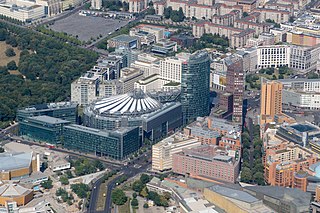
Potsdamer Platz is a public square and traffic intersection in the center of Berlin, Germany, lying about 1 km (1,100 yd) south of the Brandenburg Gate and the Reichstag, and close to the southeast corner of the Tiergarten park. It is named after the city of Potsdam, some 25 km (16 mi) to the south west, and marks the point where the old road from Potsdam passed through the city wall of Berlin at the Potsdam Gate. Initially, the open area near the city gate was used for military drills and parades. In the 19th into the 20th century, it developed from an intersection of suburban thoroughfares into the most bustling traffic intersection in Europe. The area was totally destroyed during World War II and then left desolate during the Cold War era when the Berlin Wall bisected its location. Since German reunification, Potsdamer Platz has been the site of major redevelopment projects.

Tiergarten is a locality within the borough of Mitte, in central Berlin (Germany). Notable for the great and homonymous urban park, before German reunification, it was a part of West Berlin. Until Berlin's 2001 administrative reform, Tiergarten was also the name of a borough (Bezirk), consisting of the current locality (Ortsteil) of Tiergarten plus Hansaviertel and Moabit. A new system of road and rail tunnels runs under the park towards Berlin's main station in nearby Moabit.

Erich Mendelsohn ; 21 March 1887 – 15 September 1953) was a German-British architect, known for his expressionist architecture in the 1920s, as well as for developing a dynamic functionalism in his projects for department stores and cinemas. Mendelsohn was a pioneer of the Art Deco and Streamline Moderne architecture, notably with his 1921 Mossehaus design.
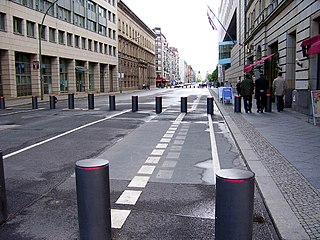
Wilhelmstrasse is a major thoroughfare in the central Mitte and Kreuzberg districts of Berlin, Germany. Until 1945, it was recognised as the centre of the government, first of the Kingdom of Prussia, later of the unified German Reich, housing in particular the Reich Chancellery and the Foreign Office. The street's name was thus also frequently used as a metonym for overall German governmental administration: much as the term "Whitehall" is often used to signify the British governmental administration as a whole. In English, "the Wilhelmstrasse" usually referred to the German Foreign Office.

Wertheim was a large department store chain in pre-World War II Germany. It was founded by Georg Wertheim and operated various stores in Berlin, one in Rostock, one in Stralsund, and one in Breslau. Its Jewish owners were forced out after 1933 by the new Nazi government. After the war, owner Karstadt operated various store branches across Germany under the Wertheim name, all of which either closed or were rebranded Karstadt.
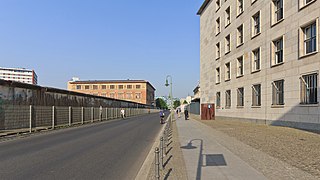
Niederkirchnerstraße is a street in Berlin, Germany and was named after Käthe Niederkirchner. The thoroughfare was known as Prinz-Albrecht-Straße until 1951 but the name was changed by the East German government. The street was the location of the SS Reich Security Main Office (RSHA), the headquarters of the Sicherheitspolizei, SD, Einsatzgruppen and Gestapo. The site is now marked by the Topography of Terror memorial and a museum, which includes a permanent exhibition showing the crimes of Nazism.

Voßstraße is a street in central Berlin, the capital of Germany. It runs east–west from Ebertstraße to Wilhelmstraße in the borough of Mitte, one street north of Leipziger Straße and very close to Potsdamer Platz. It is best known for being the location of Hitler's new Reich Chancellery complex, and the bunker where he spent his last days.

Leipziger Straße is a major thoroughfare in the central Mitte district of Berlin, capital of Germany. It runs from Leipziger Platz, an octagonal square adjacent to Potsdamer Platz in the west, to Spittelmarkt in the east. Part of the Bundesstraße 1 highway, it is today one of the city's main east–west road links.

Tiergartenstraße is a street in the Tiergarten district in central Berlin, the capital of Germany. The street runs east-west along the southern edge of the Großer Tiergarten park from Kemperplatz and Ben-Gurion-Straße near Sony Center and Potsdamer Platz in the east to the intersection of Hofjägerallee and Klingelhöferstraße in the west. On the street’s southern side, the street intersects with, Herbert-von-Karajan-Straße, Stauffenbergstraße, Hildebrandstraße, Hiroshimastraße and Clara-Wieck-Straße.
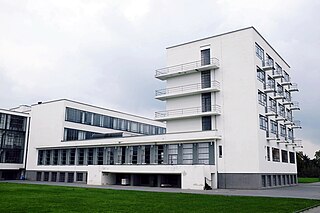
The New Objectivity is a name often given to the Modern architecture that emerged in Europe, primarily German-speaking Europe, in the 1920s and 30s. It is also frequently called Neues Bauen. The New Objectivity remodeled many German cities in this period.

Leipziger Platz is an octagonal square in the center of Berlin. It is located along Leipziger Straße just east of and adjacent to the Potsdamer Platz.

The Kulturforum is a collection of cultural buildings in Berlin. It was built up in the 1950s and 1960s at the edge of West Berlin, south of the Tiergarten, after most of the once unified city's cultural assets had been lost behind the Berlin Wall. The Kulturforum is characterized by its innovative modernist architecture; several buildings are distinguished by the organic designs of Hans Scharoun, and the Neue Nationalgalerie was designed by Mies van der Rohe. Today, the Kulturforum lies immediately to the west of the redeveloped commercial node of Potsdamer Platz.

Europahaus is a large high-rise office block in Berlin, Germany, located in the Kreuzberg district on Stresemannstraße, facing the remains of the former Anhalter Bahnhof railway terminus across Askanischer Platz. It was one of the first modern high-rise office buildings to be constructed in the city.
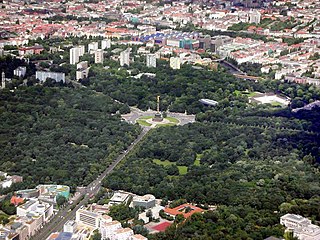
The Tiergarten, formal German name: Großer Tiergarten, is a prominent park in Berlin's inner-city area, located completely in the district of the same name. It is one of the most popular parks in the city and at 210 hectares in size, is among the largest urban gardens in Germany. Only the Tempelhofer Park and Munich's Englischer Garten are larger.

Alfred Messel was a German architect at the turning point to the 20th century, creating a new style for buildings which bridged the transition from historicism to modernism. Messel was able to combine the structure, decoration, and function of his buildings, which ranged from department stores, museums, office buildings, mansions, and social housing to soup kitchens, into a coherent, harmonious whole. As an urban architect striving for excellence he was in many respects ahead of his time. His best known works, the Wertheim department stores and the Pergamon Museum in Berlin, reflect a new concept of self-confident metropolitan architecture. His architectural drawings and construction plans are preserved at the Architecture Museum of Technische Universität Berlin.
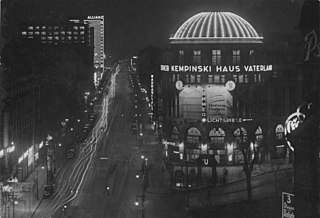
Haus Vaterland was a pleasure palace on the south-east side of Potsdamer Platz in central Berlin. Preceded by Haus Potsdam, a multi-use building including a large cinema and a huge café, from 1928 to 1943 it was a large, famous establishment including the largest cafe in the world, a major cinema, a large ballroom and numerous theme restaurants, promoted as a showcase of all nations. It was partially destroyed by fire in World War II, reopened in a limited form until 1953, and was finally demolished in 1976.

The Grand Hotel Bellevue was a hotel on the Potsdamer Platz in Berlin, Germany. It was designed by architect Ludwig Heim and opened in 1888. Initially it was called the Hôtel du Parc, later it was also known as the Thiergarten-Hotel. The hotel was demolished in 1928 and Erich Mendelsohn's modern Columbushaus skyscraper was constructed on the site, opening in 1932. It was demolished in 1957 and the site remained vacant until after German reunification, when the Beisheim Center was built there.
The Embassy of Sweden in Berlin is Sweden's diplomatic mission in Germany. Ambassador since 2017 is Per Thöresson. Sweden established a legation in Berlin in 1912. During World War II, it was destroyed in aerial bombings and the legation was moved to other addresses in Berlin. After the war, the Swedish legation moved to Cologne in West Germany, and in the mid-1950s to Bonn, where it remained until 1999. During the Cold War, Sweden also had an embassy in East Berlin from the 1970s onwards. In 1999, the new Swedish embassy in Berlin was inaugurated and the one in Bonn was closed. The building complex in which the Swedish embassy is located since 1999 is called Nordic Embassies.

























